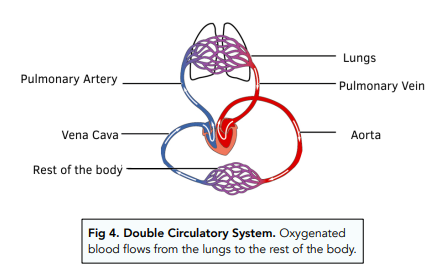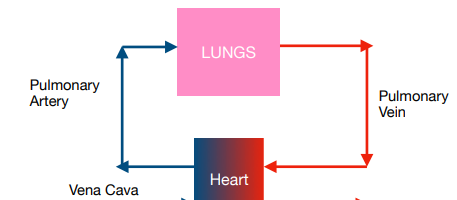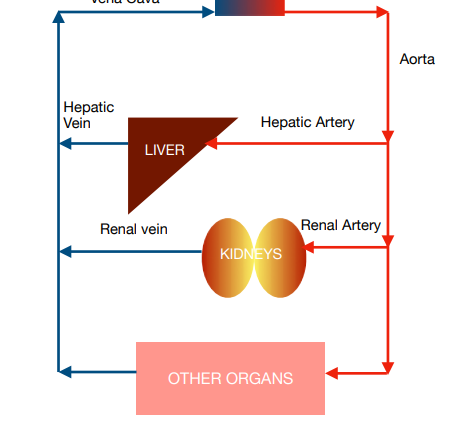Circulatory System - The Double Circulatory System (GCSE Biology)
What is a Double Circulatory System?
The double circulatory system definition is a system where blood passes through the heart twice for every complete circuit of the body. The circulatory system made up of two pathways: the pulmonary and systemic circuits. Unlike fish, other organisms’ hearts use a double circulatory system
Pulmonary Circuit
- Deoxygenated blood begins in the right atrium. Before blood can be pumped around the body, it needs to be pumped to the lungs to get oxygenated.
- The deoxygenated blood is pumped out the right ventricle. The deoxygenated blood in the right atrium is pumped into the right ventricle. From here is is pumped into the pulmonary circuit through the pulmonary artery.
- The lungs oxygenate the blood. The pulmonary circuit carries the blood to the lungs where it is oxygenated (via gas exchange).
- The oxygenated blood returns to the left atrium. Then the oxygenated blood is carried back to the heart via the pulmonary vein.
Systemic Circuit
- The oxygenated blood is ready to be pumped around the body. The oxygenated blood returns from the pulmonary circuit, and passes into the left atrium, then into the left ventricle. The oxygenated blood can now be pumped around the body in the systemic circuit.
- The oxygenated blood is pumped out of the left ventricle. From the left ventricle it is pumped out into the aorta, and is carried around the body.
- The blood gives oxygen to body cells. The blood unloads oxygen and gives it to the body’s cells. The blood becomes deoxygenated as oxygen is used up.
- The deoxygenated blood returns to the right atrium. The vena cava (veins) carry the blood (now deoxygenated) back to the heart, and the cycle starts again.

System
Advantages of Double Circulatory System
- Blood can be pumped faster around the body – this allows more oxygen to be delivered to tissues for respiration and maintaining their body temperatures.
- Blood can be pumped around the body at a higher pressure – the blood returning to the heart has already been loaded with oxygen so the heart can pump the blood around the body immediately.
Circulation to Other Organs
There are specific vessels for each organ that carry oxygenated and deoxygenated blood to and from the organ as outlined below:



System
Disadvantages of Double Circulatory System
In short, there are no disadvantages to having a double circulatory system as this system means that there is a higher supply of oxygen to the cells, which is more efficient. However, there are circulatory system diseases that can affect your heart and blood vessels, making it more difficult for blood to flow through the system.
FAQs
Mammals (such as humans) need an efficient blood flow system to supply blood to tissues and remove the waste produced. Due to the large nature of this system in humans, a higher blood pressure is needed compared to other animals. The double circulatory system ensures that oxygen is pumped through our body including the lungs where we can breathe in oxygen and dispel carbon dioxide.
The double circulatory system is so-called because blood passes through the heart twice in a round. The first time, deoxygenated blood is pumped from the right side of the heart to the lungs, which is then oxygenated and returns back to the left side of the heart.
The circulatory system in biology is a network of blood vessels and the heart that transports blood, oxygen, and nutrients to all parts of the body.
The double circulatory system works by having two separate circuits, the pulmonary circuit and the systemic circuit. The pulmonary circuit carries deoxygenated blood from the heart to the lungs, where it is oxygenated and then returned to the heart. The systemic circuit carries oxygenated blood from the heart to the rest of the body.
The heart plays a central role in the double circulatory system as it pumps blood through the two circuits. It has two atria and two ventricles, which allow it to separate oxygenated and deoxygenated blood.
The double circulatory system benefits mammals and birds by providing a more efficient way of transporting oxygen and nutrients to the body. It allows for a greater volume of blood to be pumped with each heartbeat, which provides tissues with more oxygen and nutrients.
The main difference between the double and single circulatory systems is the number of times that blood is pumped through the body in one complete cycle. In the double circulatory system, blood is pumped through the body twice, whereas in the single circulatory system, it is only pumped once.
The double circulatory system contributes to the functioning of the body by providing oxygen and nutrients to tissues, removing waste products, and regulating the body’s temperature. It also plays a role in maintaining blood pressure and supporting physical activity.






Still got a question? Leave a comment
Leave a comment